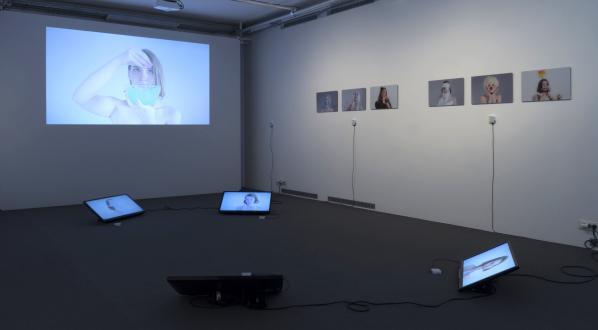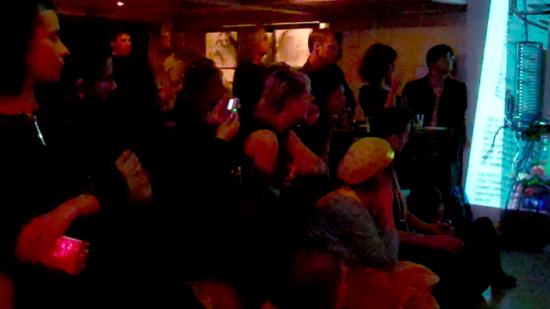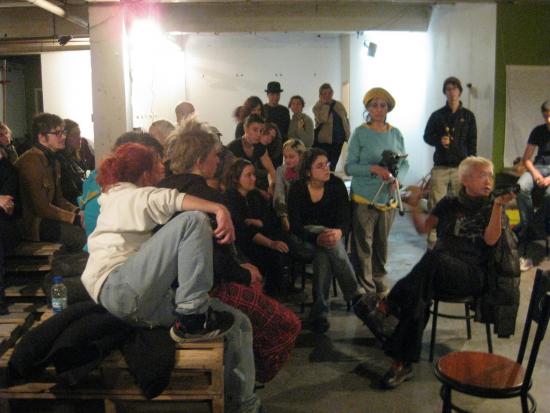



Feature image:
Iza Pavlina, “Rule 34”, solo exhibition, Aksioma Project Space, Ljubljana, Slovenia 19 April – 12 May 2017
The Aksioma Project Space hosting Iza Pavlina’s “Rule 34“ exhibition is an immaculate visual realisation of a lifestyle minimalist’s wet dream. There are two large video projections covering the surfaces of opposite walls in the white cube. Another set of four monitors is tilted on the floor, beaming at you towards the center of the space. All projections show the same composition of a young woman, the artist herself, on a clear background, overwhelmingly beautiful and innocent, mildly disinterested, bare-shouldered, engaged in playing repetitively with a different toy in each video. The third wall is neatly adorned with a set of six C-print photos with the same flawless composition. The last wall presents outlined drawings of yet the same composition, stamped with a QRcode of pages like Pornhub, xHamster, and Xvideos. Each QRcode leads to the artist’s profile on different social media sites, where the same set of perfect videos are presented. Perhaps you have no idea what these sites are, but if you are one of a quarter of internet users who frequent online porn sites, the chances are that your own profiles on these sites are your deeply buried dirty secret.
Much like any other of your favorite social media sites, porn sites include a public profile for the gaze of all your friends and a private space for personal chats. How Web 2.0 has changed the meaning of concepts such as friends, public and private space is beside the point; What is meaningful for the exhibition is that Pavlina lets you take a sneak peek into private messages she has had with her friends, or rather fans, on these sites. For this private viewing, she adopted an exhibition format called “offline art”, which was initially developed by German artist Aram Bartholl. Essentially, every video or photo is connected to a local Wi-Fi router, which lets you hub into a specific private chat. Here is where the titillation, arousal, curiosity, surprise, even shock or disgust emerge – here, in this secret hidden space, where the boundaries of mainstream porn as we know it are challenged and explored.
Somehow, Pavlina’s interest in sexuality, pornography, and paraphilias is well summarized in the title itself. The rules of behaviour for being on the internet were posted on meme-sharing sites like 4chan.org sometime back in 2004. Rule 34 says: “There is porn of it, no exceptions.” The following two rules clarify the statement. Rule 35 says “If no porn is found of it, it will be made,” and Rule 36: “There will always be more fucked up shit than what you just saw.” [Paasonen, 2011] These three rules alone show that the diversity of pornographic exploration has exploded with the easy accessibility and seeming anonymity of online identities. Social taboos have been lost somewhere in the translation of the meaning of the virtual i.e digital. For a time, it was believed online porn had little effect on the corporeal, and the social taboo and guilt associated with it seemed not to be applicable. But it has turned out that fiddling with oneself on the internet is just as carnal. As a young artist in her 20s, Pavlina started exploring the subject a few years ago with her half-hour video piece “Talk to Strangers!” (2014). This piece was edited from online video chats, during which she pretended to be a 14-year-old girl. With this piece, she was trying to “highlight and expose in an original and unobtrusive way the global issue of disorders of sexual preference and the incidence of paedophilia on the World Wide Web”. However, in the “Rule 34” exhibition, she takes a turn from a legal and moralistic point of view towards a more uncharted and ambivalent pornographic landscape. Interestingly enough, the kink of mainstream heteronormative sexuality is a topic which really appeals to artists and researchers alike. There is a wide acceptance and interest for alternative porn in the arts, whether it is vintage, humorous or LGBT, while the mainstream is often disregarded as tacky, normative or even filthy. The first set of genres is easy to read since they obviously produce a set of meanings in the field of cultural critique. The mainstream, however, bemuses.

Now it is time to explore the toys Iza Pavlina is playing with. For her videos, she has chosen a set of less known and quite surprising paraphilias, which produce an intense sexual arousal for specific individuals. The activities may seem usual or even quite ridiculous to another individual who is turned on by something completely different. In the process of making “Rule 34”, she has uploaded the videos to her profile on various pornographic social media sites with the name of a specific paraphilia and a teasing description such as “Agalmatophilia: Virgin turns into a fuck robot”, “Balloon fetishism: Young looner babe blowing her first balloon”, “Exophilia: Nasty girl playing with balls”, “Pony play: Wild pony getting trained”, “Plushophilia: Hot naked blonde cuddling her teddy bear”, “Trichophilia: Submissive bitch gets her hair chopped off”. In these descriptions, there are a number of clichéd identifications such as blondeness, paleness, youthfulness and submissiveness, which suggests a blunt disregard for the question of race and other identities, yet she somehow evades the need for the interpretation of her actions. The videos are visceral and saturated with body and presence, yet surprisingly unintrusive. Her action is not trying to identify with the fetish nor to imitate the fantasy, but to become it. And she does so with a laboratory accuracy. The work seems to treat corporeality in Elizabeth Grosz’s terms, proposing the presence of the body without the need to reduce it to semiotic inscriptions or the assertion of meanings.
Even though the artist creates a set of online identities, she seems not to be interested in the question of mimicry or fake personalities. On the contrary, she becomes and plays with these identities, interacting with her friends or rather fans, who she teases, tempts, and attracts. She is interested in the performativity of the body, and its capability to speak for itself. As Susan Paasonen would put it, the interest lies in “resonance”, which equally “encompasses the emotional and cognitive as well as the sensory and affective” (Paasonen, 2011, 27), producing intensity, appeal, and force. “Rule 34” does not produce any metaphorical meaning, and perhaps this novelty within the storytelling of a young generation becomes most obvious if we try and compare it to an older example of paraphilia in arts. For example, we may associate the injury fetishism, which Pavlina also explores, with J.G. Ballard‘s book “Crash” and its film translation by David Cronenberg. Ballard himself explained it as a result of “the marriage of reason and nightmare, which has dominated the 20th century with its sinister technologies and the dreams that money can buy”; It is a “the merging of sex and paranoia” and “the death of affect”.

Pavlina however, finds no fear in the omnipresence of technology and the visceral connection between the human body and technological tools. She seems to value only the “resonance” of technology, regardless of what cultural conditions it is produced in. She is liberating the list of fetishes and fantasies from the history of treating sexuality in clinical terms, since the normality of desire has been culturally produced and theoretically reduced to a psychoanalytic understanding of suppressed memories, phobias and philias. There is absolutely nothing psychoanalytical about “Rule 34”. The artist goes against the understanding of paraphilias as objects of perversions. She plays and enjoys the outcome, communicates with fans and haters, and even lets the gallery visitor to sneak peek into private messages with particularly kinky content. One of these is “Cum Tribute” – the act of cumming on a printed picture, monitor or pad, which has so often been contributed to her gorgeousness, that she received in private messages for every video she uploaded. By documenting such actions, she has archived a behavioural phenomenon that is completely off the chart from conventional archives, and in her playful exploration of mainstream porn, she seems to reassure: there is nothing normative about any sexuality and that’s just fine.

Image by Alice Alexandrescu.
This year’s edition of Artivistic brings the fields of art, politics and academia together under the theme of TURN*ON.
Eventually, the investigation about systems of representation – be they semiotic, informational or political – might slip into the one psychoanalysis considers the most elementary and surreptitious of them all: sex. That’s precisely where the Artivistic gathering got into in its fourth edition, which happened in Montreal from 15th to 17th October. To be exact, the theme under which the event tied the fields of art, politics and academia together was TURN*ON – according to its curatorial statement, ‘a fragile bridge extending, over a valley of which the depth you cannot see, to a life centered on pleasure, consciousness, togetherness, understanding, and joy’.
Formulated this way, the concept seems to be a response to the well-worn verses by journalist Eduardo Galeano, in which he states that utopia ’causes us to advance’ only because it ‘lies in the horizon’. With turn on, Artivistic proposes that the forces that move people forward and bring worlds into existence are not far away: in a scenario emptied of grand narratives, the desire (of the self?) should gain preponderance over any masterplans (of the party?).
So, if libido is the why, could we say that art is the how? As crude as it can be, this comparison makes clear that aesthetics, just as politics, mainly operate in the level of methods. They are more concerned with the way desire is manipulated (often repressed or enhanced) than with its ontological truth. Language cannot explain affect, and it shouldn’t pretend to – the best it can do is create spaces for its continuous exercise.

In that sense, what really stood out during the event were the workshops. I wouldn’t go as far as to agree with the idea that such activities are a distinct genre within the contemporary art circuit. Workshops indeed revitalize the exhibition space – however, they do so not by occupying it with new forms, but by proposing new forms of occupying it. In Artivistic, these interfaces ranged from diy electronics and card game design to pornographic filmmaking and even a kind of un-workshop on workshops! Among those, there was a remarkable amount of projects concerning the performative of one’s own identity.
In fact, the workshops punctuated Artivistic in a not much different way than the everyday activities of cooking and eating in group (or translating things to French or English – it was a true bilingual event). One thing led to another, keeping the gathering together in spite of the healthy excess of participant autonomy allowed by the organization crew. Of course, the concentration of (almost) all activities in the same place helped building this integration. This was a strategic option, very coherent with the intimate theme of this edition; the former Artivistic, about un.occupied spaces, had been distributed in different venues throughout Montreal.
The integration of the participants was so successful it had the minor side effect of creating an almost self-centred environment. Even though some activities would have been very interesting for people outside regular art-audience, it was hard to see among the public someone besides those that were immersed 24/7 in the event. For instance, it was a pity that the orgasmic birth workshop, which introduced alternative ways of pregnancy and labour, had no pregnant women participating.
This paradoxical isolation was imploded in the last night of the event – most ironically, not by the long-waited closing performance Resist Me Release Me: Turn On Act On, which artist Shu Lea Cheang had been organising with the participants throughout the gathering, but because of its impending cancellation. It seems that the managers of the venue where Artivistic was happening had not understood that the event would contain nudity and explicit sexual acts, and took account of this just in time of the final soiree. Since they had no public license to host this kind of activity, they said it was impossible to have the performance there: either it had to be suspended or transferred elsewhere.

The organizers explained this incident to the participants and called for a collective decision. That immediately ignited a very intense discussion, where it became clear that what was at hand was not mere censorship, but a very subtle negotiation of the different spheres that Artivistic addressed. The autonomy people were requesting was not sexual, but artistic – ‘we do not intend to do an orgy, but performances’, as someone said. Hence, it was not a simple conflict between raw libidinal impulse and oppressive morality; it concerned more complex, structured systems – i.e. art and Montreal society, both already contradictory in themselves.
I dare say that some solutions proposed in this debate – for example, live-streaming the works from another place or ‘censoring’ performances in real-time – were way more interesting than any prescripted show might have been. These proposals were the sign of an art that was alive and kicking, ready to respond emergencies and fight back, instead of just claiming its secular, innocuous freedom (a freedom that critic Julian Stallabrass very cunningly regards as supplementary to that of the market).
The result was that in a couple hours the whole programme for the night was adapted and moved to a venue nearby, in a beautifully orchestrated, self-organized effort. Unfortunately, due to limitations of structure and space, not everything that had been planned before could be presented. Nevertheless, the accident had allowed the necessary hands-on without which a turn on just fades away, and something bigger was engendered in the process – I’d say revolutionary freedom, a kind of autonomy that, as the old leftist maxima states, must always be conquered.
Links:
Featured image: abstract animated visual models working from the audio samples of couples engaging in sexual activities.
Frequency Love is a net art piece, not in the networked sense but conceptually filled to the brim with a net consciousness, a net object. This visual deviation playfully captures the dark side of the Internet and its globally collective and obsessive mannerist activities. It reveals a psychological nuance of the everyday Internet sexual experience.
The source material were originally sound files – mp3’s, consisting of couples copulating. Amateurs submitting and declaring their intimately entwined, feral and visceral exertions for other interested parties to hear and enjoy online. Chris Webb abstracted the audio, the data and transformed them into what now are animated gif images of couples having sex.
There is a contradiction at play built by circumstance, that such esoteric interests of sharing intimate, sexual sound files in virtual private clubs do tend to exude. The inevitable occurs. If the multitude of surfers, search hard enough on the net, they collect hidden information by hook or crook somehow; which is part of the nature of using the Internet medium.
When viewing these works it is as though they are breathing, as if they are real souls, real people, even though you know that they are invented visuals, data into sound. Then you remember that they were real people, but mutated into visual form. The ‘Plexus’, culmination of networked, linked individuals expressing proclivity and what seems an uncontrollable hunger to communicate in a way other than by words, via the motion of sexual intercourse in audio format. There has been a global shift of people exploring new territories regarding their own relational selves. The term virtual is essence of the Internet medium and we used to think that this word stood for the unreal, untouchable but now we know that this is no longer applicable. It is now part of our everyday experience, therefore real.